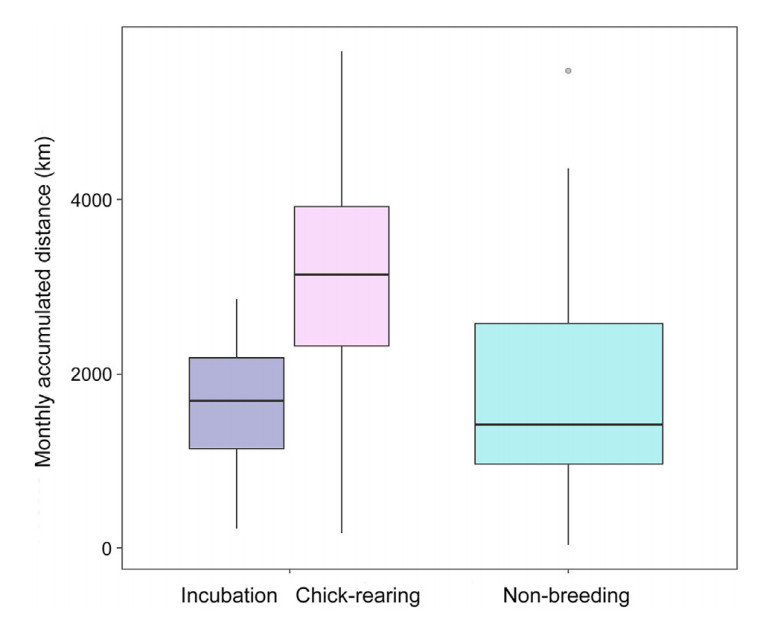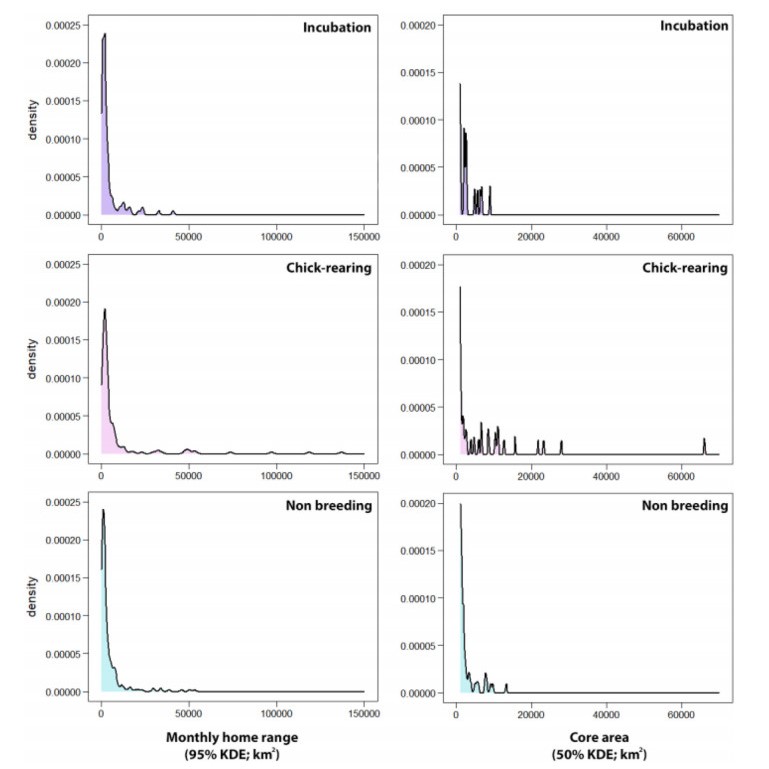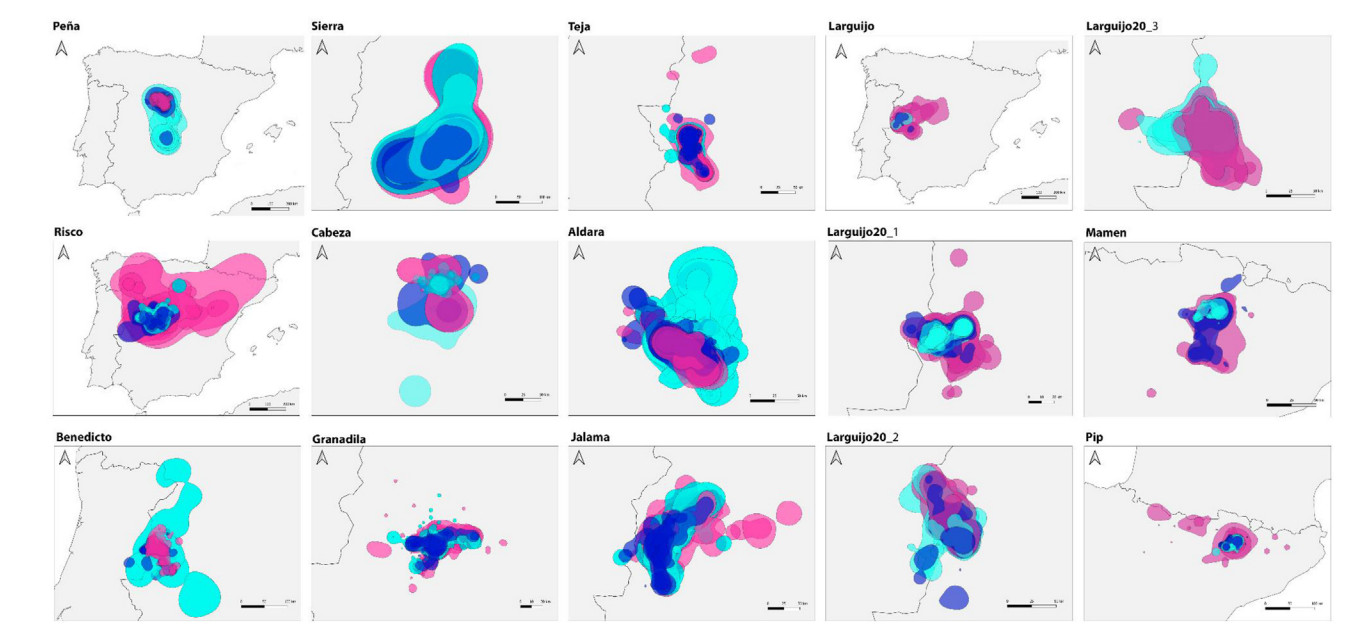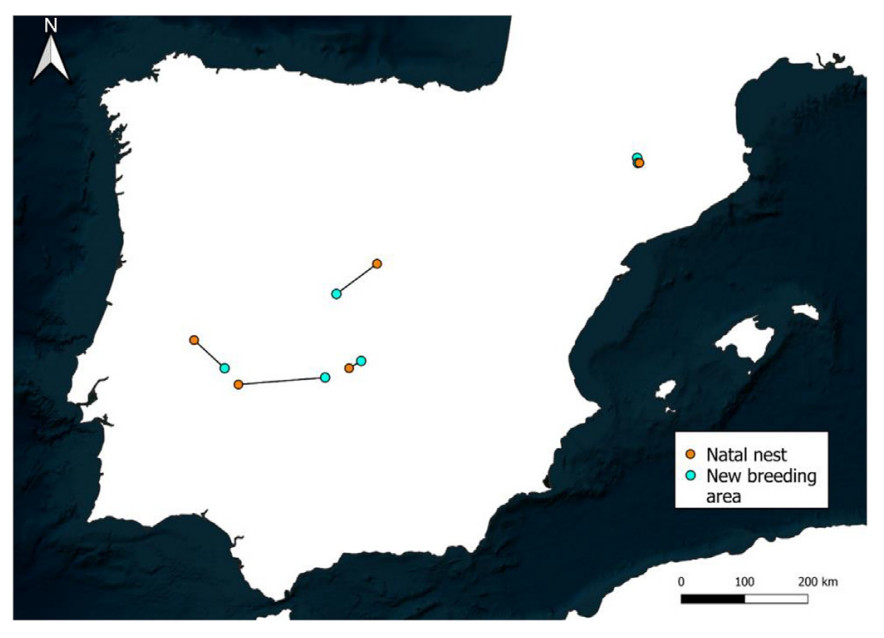Abellán, P., Carrete, M., Anadón, J.D., Cardador, L., Tella, J.L., 2016. Non-random patterns and temporal trends (1912-2012) in the transport, introduction and establishment of exotic birds in Spain and Portugal. Divers. Distrib. 22, 263-273. .
|
Baquero, R.A., Barbosa, A.M., Ayllón, D., Guerra, C., Sánchez, E., Araújo, M.B., et al., 2021. Potential distributions of invasive vertebrates in the Iberian Peninsula under projected changes in climate extreme events. Divers. Distrib. 27, 2262-2276. .
|
|
Bates, D., Maechler, M., Bolker, B., Walker, S., Bojesen Christensen, R.H., Singmann, H., et al., 2015. Package "lme4": Linear Mixed-Effects Models using "Eigen" and S4. J. Stat. Software 67, 1-48.
|
Bensch, S., Pérez-Tris, J., Waldenström, J., Hellgren, O., 2004. Linkage between nuclear and mitochondrial DNA sequences in avian malaria parasites: multiple cases of cryptic speciation? Evolution 58, 1617-1621. doi: .
|
Bensch, S., Hellgren, O., Pérez-Tris, J., 2009. MalAvi: a public database of malaria parasites and related haemosporidians in avian hosts based on mitochondrial cytochrome b lineages. Mol. Ecol. Resour. 9, 1353-1358.
|
Blackburn, T.M., Ewen, J.G., 2017. Parasites as drivers and passengers of human-mediated biological invasions. Ecohealth 14, 61-73. .
|
|
Blackburn, T.M., Lockwood, J.L., Cassey, P., 2009. Avian Invasions: The Ecology and Evolution of Exotic Birds. Oxford University Press, Oxford.
|
Booth, C.E., Elliott, P.F., 2002. Hematological responses to hematozoa in North American and neotropical songbirds. Comp. Biochem. Physiol. A Mol. Integr. Physiol. 133, 451-467.
|
|
Campbell, T. W., Ellis, C. K., 2007. Avian & Exotic Animal Hematology and Cytology. Blackwell, Ames, Iowa.
|
Cardoso, G.C., Reino, L., 2018. Ecologically benign invasions: the invasion and adaptation of Common Waxbills ( Estrilda astrild) in Iberia. In: Queiroz, A., Pooley, S. (Eds.), Histories of Bioinvasions in the Mediterranean. Environmental History, vol. 8. Springer, Cham, pp. 149-169. .
|
Carrete, M., Tella, J.L., 2008. Wild-bird trade and exotic invasions: a new link of conservation concern? Front. Ecol. Environ. 6, 207-211. https://www.jstor.org/stable/20440873.
|
Chinchio, E., Crotta, M., Romeo, C., Drewe, J.A., Guitian, J., Ferrari, N., 2020. Invasive alien species and disease risk: an open challenge in public and animal health. PLoS Pathog. 16, e1008922. .
|
Christe, P., Møller, A.P., González, G., de Lope, F., 2002. Intraseasonal variation in immune defence, body mass and hematocrit in adult house martins Delichon urbica. J. Avian Biol. 33, 321-325. .
|
Cornet, S., Bichet, C., Larcombe, S., Faivre, B., Sorci, G., 2014. Impact of host nutritional status on infection dynamics and parasite virulence in a bird-malaria system. J. Anim. Ecol. 83, 256-265. .
|
Crowl, T.A., Crist, T.O., Parmenter, R.R., Belovsky, G., Lugo, A.E., 2008. The spread of invasive species and infectious disease as drivers of ecosystem change. Front. Ecol. Environ. 6, 238-246. .
|
Damas-Moreira, I., Riley, J.L., Carretero, M.A., Harris, D.J., Whiting, M.J., 2020. Getting ahead: exploitative competition by an invasive lizard. Behav. Ecol. Sociobiol. 74, 117. .
|
Dawson, R.D., Bortolotti, G.R., 2000. Effects of hematozoan parasites on condition and return rates of American Kestrels. Auk 117, 373-380.
|
Delhaye, J., Glaizot, O., Christe, P., 2018. The effect of dietary antioxidant supplementation in a vertebrate host on the infection dynamics and transmission of avian malaria to the vector. Parasitol. Res. 117, 2043-2052.
|
Dimitrov, D., Marinov, M.P., Bobeva, A., Ilieva, M., Bedev, K., Atanasov, T., et al., 2019. Haemosporidian parasites and leukocyte profiles of pre-migratory rosy starlings ( Pastor roseus) brought into captivity. Anim. Migr. 6, 41-48. .
|
Emiroğlu, Ö., Atalay, M.A., Ekmekçi, F.G., Aksu, S., Başkurt, S., Keskin, E., et al., 2020. One of the world's worst invasive species, Clarias batrachus (Actinopterygii: Siluriformes: Clariidae), has arrived and established a population in Turkey. Acta Ichthyol. Piscat. 50, 391-400.
|
Essl, F., Nehring, S., Klingenstein, F., Milasowszky, N., Nowack, C., Rabitsch, W., 2011. Review of risk assessment systems of IAS in Europe and introducing the German-Austrian Black List Information System (GABLIS). J. Nat. Conserv. 19, 339-350.
|
Fair, J., Whitaker, S., Pearson, B., 2007. Sources of variation in haematocrit in birds. Ibis 149, 535-552. .
|
Falaschi, M., Melotto, A., Manenti, R., Ficetola, G.F., 2020. Invasive species and amphibian conservation. Herpetologica 76, 216-227. .
|
Fallis, A.M., Smith, S.M., 1964. Ether extracts from birds and CO 2 as attractants for some ornithophilic simuliids. Can. J. Zool. 42, 723-730. .
|
Galván, I., Sanz, J.J., 2006. Feather mite abundance increases with uropygial gland size and plumage yellowness in Great Tits Parus major. Ibis 148, 687-697.
|
García-Longoria, L., Marzal, A., de Lope, F., Garamszegi, L., 2019. Host-parasite interaction explains variation in the prevalence of avian haemosporidians at the community level. PLoS One 14, e0205624.
|
González, G., Sorci, G., Møller, A.P., Ninni, P., Haussy, C., de Lope, F., 1999. Immunocompetence and condition-dependent sexual advertisement in male house sparrows ( Passer domesticus). J. Anim. Ecol. 68, 1225-1234.
|
Granthon, C., Williams, D.A., 2017. Avian malaria, body condition, and blood parameters in four species of songbirds. Wilson J. Ornithol. 129, 492-508.
|
Hahn, S., Bauer, S., Dimitrov, D., Emmenegger, T., Ivanova, K., Zehtindjiev, P., et al., 2018. Low intensity blood parasite infections do not reduce the aerobic performance of migratory birds. Proc. R. Soc. B-Biol. Sci. 285, 20172307. .
|
Hall, T.A., 1999. BIOEDIT: a user-friendly biological sequence alignment editor and analysis program for Windows 95/98/ NT. Nucleic Acids Symp. Ser. 41, 95-98. .
|
Health, W., Who, O., 2021. WHO Guidelines for Malaria. World Health Organization, Geneva. .
|
Hellgren, O., Waldenström, J., Bensch, S., 2004. A new PCR assay for simultaneous studies of Leucocytozoon, Plasmodium, and Haemoproteus from avian blood. J. Parasitol. 90, 797-802. .
|
Hõrak, P., Jenni-Eiermann, S., Ots, I., Tegelmann, L., 1998. Health and reproduction: the sex-specific clinical profile of great tits ( Parus major) in relation to breeding. Can. J. Zool. 76, 2235-2244.
|
Ilgūnas, M., Bukauskaitė, D., Palinauskas, V., Iezhova, T.A., Dinhopl, N., Nedorost, N., et al., 2016. Mortality and pathology in birds due to Plasmodium ( Giovannolaia) homocircumflexum infection, with emphasis on the exoerythrocytic development of avian malaria parasites. Malar. J. 15, 256. .
|
Ishtiaq, F., Barve, S., 2018. Do avian blood parasites influence hypoxia physiology in a high elevation environment? BMC Ecol. 18, 15. .
|
Ishtiaq, F., Gering, E., Rappole, J.H., Rahmani, A.R., Jhala, Y.V., Dove, C.J., et al., 2007. Prevalence and diversity of avian hematozoan parasites in Asia: a regional survey. J. Wildl. Dis. 43, 382-398. .
|
James, J., Mrugała, A., Oidtmann, B., Petrusek, A., Cable, J., 2017. Apparent interspecific transmission of Aphanomyces astaci from invasive signal to virile crayfish in a sympatric wild population. J. Invertebr. Pathol. 145, 68-71.
|
Jarić, I., Cvijanović, G., 2012. The tens rule in invasion biology: measure of a true impact or our lack of knowledge and understanding? Environ. Manage. 50, 979-981.
|
Jeschke, J.M., 2014. General hypotheses in invasion ecology. Divers. Distrib. 29, 1229-1234. .
|
Jovani, R., Tella, J.L., 2006. Parasite prevalence and sample size: misconceptions and solutions. Trends Parasitol. 22, 214-218. .
|
Kearse, M., Moir, R., Wilson, A., Stones-Havas, S., Cheung, M., Sturrock, S., et al., 2012. Geneious basic: an integrated and extendable desktop software platform for the organization and analysis of sequence data. Bioinformatics 28, 1647-1649. .
|
Kettunen, M., Genovesi, P., Gollasch, S., Pagad, S., Starfinger, U., ten Brink, P., et al., 2008. Technical Support to EU Strategy on Invasive Species (IAS) – Assessment of the Impacts of IAS in Europe and the EU (Final Module Report for the European Commission). Institute for European Environmental Policy (IEEP), Brussels. .
|
Krams, I., Cirule, D., Krama, T., Hukkanen, M., Rytkönen, S., Grell, M., et al., 2010. Effects of forest management on haematological parameters, blood parasites, and reproductive success of the Siberian tit ( Poecile cinctus) in northern Finland. Ann. Zool. Fennici 47, 335-346. .
|
Krams, I., Suraka, V., Rantala, M.J., Sepp, T., Mierauskas, P., Vrublevska, J., et al., 2013. Acute infection of avian malaria impairs concentration of haemoglobin and survival in juvenile altricial birds. J. Zool. 291, 34-41.
|
Lima, M.R., Simpson, L., Fecchio, A., Kyaw, C.M., 2010. Low prevalence of haemosporidian parasites in the introduced house sparrow ( Passer domesticus) in Brazil. Acta Parasitol. 55, 297-303. .
|
|
Lipa, J.J., 2013. The Impacts of Invasive Alien Species in Europe. European
Environmental Agency Technical, Copenhagen. Report No. 16/2012.
|
Lopes, R.J., Correia, J., Batalha, H., Cardoso, G.C., 2018. Haemosporidian parasites missed the boat during the introduction of common waxbills ( Estrilda astrild) in Iberia. Parasitology 145, 1493-1498. .
|
|
Lowe, S., Browne, M., Boudjelas, S., de Poorter, M., 2000. 100 of the World's Worst
Invasive Alien Species: A Selection from the Global Invasive Species Database. The
Invasive Species Specialist Group (ISSG) - a Specialist Group of the Species Survival
Commission. SSC of the World Conservation Union (IUCN), New Zealand.
|
Lutz, H.L., Hochachka, W.M., Engel, J.I., Bell, J.A., Tkach, V.V., Bates, J.M., et al., 2015. Parasite prevalence corresponds to host life history in a diverse assemblage of Afrotropical birds and haemosporidian parasites. PLoS One 10, e0128851.
|
MacLeod, C.J., Paterson, A.M., Tompkins, D.M., Duncan, R.P., 2010. Parasites lost - do invaders miss the boat or drown on arrival? Ecol. Lett. 13, 516-527. .
|
Magallanes, S., Møller, A.P., García-Longoria, L., de Lope, F., Marzal, A., 2016. Volume and antimicrobial activity of secretions of the uropygial gland are correlated with malaria infection in house sparrows. Parasites Vectors 9, 232. .
|
Magallanes, S., Møller, A.P., Luján-Vega, C., Fong, E., Vecco, D., Flores-Saavedra, W., et al., 2021. Exploring the adjustment to parasite pressure hypothesis: differences in uropygial gland volume and haemosporidian infection in palearctic and neotropical birds. Curr. Zool. 67, 147-156. .
|
Magory Cohen, T., Hauber, M.E., Akriotis, T., Crochet, P., Karris, G., Kirschel, A.N.G., et al., 2022. Accelerated avian invasion into the Mediterranean region endangers biodiversity and mandates international collaboration. J. Appl. Ecol. 59, 1440-1455. .
|
Maguire, I., Jelić, M., Klobučar, G., Delpy, M., Delaunay, C., Grandjean, F., 2016. Prevalence of the pathogen Aphanomyces astaci in freshwater crayfish populations in Croatia. Dis. Aquat. Organ. 118, 45-53. .
|
Martínez-de La Puente, J., Merino, S., Tomás, G., Moreno, J., Morales, J., Lobato, E., et al., 2010. The blood parasite Haemoproteus reduces survival in a wild bird: a medication experiment. Biol. Lett. 6, 663-665. .
|
Marzal, A., García-Longoria, L., 2020. The role of malaria parasites in invasion biology. In: Santiago-Alarcon, D., Marzal, A. (Eds.), Avian Malaria and Related Parasites in the Tropics. Springer, Cham, pp. 487-512. .
|
Marzal, A., Ricklefs, R.E., Valkiūnas, G., Albayrak, T., Arriero, E., Bonneaud, C., et al., 2011. Diversity, loss, and gain of malaria parasites in a globally invasive bird. PLoS ONE 6, e21905.
|
Marzal, A., Balbontín, J., Reviriego, M., García-Longoria, L., Relinque, C., Hermosell, I.G., et al., 2016. A longitudinal study of age-related changes in Haemoproteus infection in a passerine bird. Oikos 125, 1092-1099. doi: .
|
Marzal, A., Møller, A.P., Espinoza, K., Morales, S., Luján-Vega, C., Cardenas-Callirgos, J.M., et al., 2018. Variation in malaria infection and immune defence in invasive and endemic house sparrows. Anim. Conserv. 21, 505-514.
|
Marzal, A., Ferraguti, M., Muriel, J., Magallanes, S., Ortiz, J.A., García-Longoria, L., et al., 2022. Circulation of zoonotic flaviviruses in wild passerine birds in western Spain. Vet. Microbiol. 268, 109399.
|
|
Matias, R., 2002. Aves Exoticas Que Nidificam Em Portugal Continental, first ed. ICN, Lisbon.
|
|
Matias, R., Catry, P., Costa, H., Elias, G., Jara, J., Moore, C.C., et al., 2007. Systematic list of the birds of Mainland Portugal. An. Ornitol. 5, 74-132.
|
Mazza, G., Tricarico, E., Genovesi, P., Gherardi, F., 2014. Biological invaders are threats to human health: an overview. Ethol. Ecol. Evol. 26, 112-129. .
|
McClure, K.M., Fleischer, R.C., Kilpatrick, A.M., 2020. The role of native and introduced birds in transmission of avian malaria in Hawaii. Ecology 101, e03038. .
|
Molina, B., Nebreda, A., Muñoz, A.R., Seoane, J., Real, R., Bustamante, J., et al., 2022. III Atlas de aves en época de reproducción en España. SEO/BirdLife. .
|
Møller, A.P., Arriero, E., Lobato, E., Merino, S., 2009. A meta-analysis of parasite virulence in nestling birds. Biol. Rev. 84, 567-588. .
|
Moreno-Rueda, G., 2015. Body-mass-dependent trade-off between immune response and uropygial gland size in house sparrows Passer domesticus. J. Avian Biol. 46, 40-45. .
|
Moreno-Rueda, G., 2017. Preen oil and bird fitness: a critical review of the evidence. Biol. Rev. 92, 2131-2143. doi: .
|
Morinha, F., Carrete, M., Tella, J.L., Blanco, G., 2020. High prevalence of novel beak and feather disease virus in sympatric invasive parakeets introduced to Spain from Asia and South America. Diversity 12, 192. .
|
Muriel, J., 2020. Ecophysiological assessment of blood haemosporidian infections in birds. Ecosistemas 29, 1979. .
|
Muriel, J., Marzal, A., Magallanes, S., García-Longoria, L., Suarez-Rubio, M., Bates, P.J.J., et al., 2021. Prevalence and diversity of avian haemosporidians may vary with anthropogenic disturbance in tropical habitats in Myanmar. Diversity 13, 111. .
|
Navarro, C., Marzal, A., de Lope, F., Møller, A.P., 2003. Dynamics of an immune response in house sparrows Passer domesticus in relation to time of day, body condition and blood parasite infection. Oikos 101, 291-298. doi: .
|
Neto, J.M., Mellinger, S., Halupka, L., Marzal, A., Zehtindjiev, P., Westerdahl, H., 2020. Seasonal dynamics of haemosporidian (Apicomplexa, Haemosporida) parasites in house sparrows Passer domesticus at four European sites: comparison between lineages and the importance of screening methods. Int. J. Parasitol. 50, 523-532. .
|
Norte, A.C., Ramos, J.A., Sampaio, H.L., Sousa, J.P., Sheldon, B.C., 2010. Physiological condition and breeding performance of the Great Tit. Condor 112, 79-86. .
|
Nylund, V., Westman, K., 2000. The prevalence of crayfish plague ( Aphanomyces astaci) in two signal crayfish ( Pacifastacus leniusculus) populations in Finland. J. Crustacean Biol. 20, 777-785. .
|
Palinauskas, V., Valkiūnas, G., Bolshakov, C.V., Bensch, S., 2011. Plasmodium relictum (lineage SGS1) and Plasmodium ashfordi (lineage GRW2): the effects of the co-infection on experimentally infected passerine birds. Exp. Parasitol. 127, 527-533. .
|
Pap, P.L., Vágási, C.I., Osváth, G., Mureşan, C., Barta, Z., 2010. Seasonality in the uropygial gland size and feather mite abundance in house sparrows Passer domesticus: natural covariation and an experiment. J. Avian Biol. 41, 653-661. .
|
Pap, P.L., Vágási, C.I., Bǎrbos, L.A., Marton, A., 2013. Chronic coccidian infestation compromises flight feather quality in house sparrows Passer domesticus. Biol. J. Linn. Soc. 108, 414-428. .
|
Peel, M.C., Finlayson, B.L., Mcmahon, T.A., 2007. Updated world map of the Köppen-Geiger climate classification. Hydrol. Earth Syst. Sci. Discuss. 4, 439-473. .
|
R Core Team, 2019. R: a language and environment for statistical computing. R Foundation Stat. .
|
Ricklefs, R.E., Swanson, B.L., Fallon, S.M., Martínez-Abrain, A., Scheuerlein, A., Gray, J., et al., 2005. Community relationships of avian malaria parasites in southern Missouri. Ecol. Monogr. 75, 543-559.
|
van Riper III, C., van Riper, S.G., Goff, M.L., Laird, M., 1986. The epizootiology and ecological significance of malaria in Hawaiian landbirds. Ecol. Monogr. 56, 327-344. .
|
de Roode, J.C., Helinski, M.E.H., Anwar, M.A., Read, A.F., 2005a. Dynamics of multiple infection and within-host competition in genetically diverse malaria infections. Am. Nat. 166, 531-542.
|
de Roode, J.C., Pansini, R., Cheesman, S.J., Helinski, M.E.H., Huijben, S., Wargo, A.R., et al., 2005b. Virulence and competitive ability in genetically diverse malaria infections. P. Natl. Acad. Sci. USA 102, 7624-7628.
|
Roy, H.E., Rabitsch, W., Scalera, R., Stewart, A., Gallardo, B., Genovesi, P., et al., 2018. Developing a framework of minimum standards for the risk assessment of alien species. J. Appl. Ecol. 55, 526-538. .
|
Russell, C.B., Hunter, F.F., 2005. Attraction of Culex pipiens/restuans (Diptera: Culicidae) mosquitoes to bird uropygial gland odors at two elevations in the Niagara Region of Ontario. J. Med. Entomol. 42, 301-305. .
|
Sánchez-Guzmán, J.M., Villegas, A., Corbacho, C., Morán, R., Marzal, A., Real, R., 2004. Response of the haematocrit to body condition changes in Northern Bald Ibis Geronticus eremita. Comp. Biochem. Phys. A 139, 41-47.
|
Sandland, G.J., Minchella, D.J., 2004. Life-history plasticity in hosts ( Lymnaea elodes) exposed to differing resources and parasitism. Can. J. Zool. 82, 1672-1677. .
|
Santiago-Alarcon, D., Marzal, A., 2020. Research on avian haemosporidian parasites in the tropics before the year 2000. In: Santiago-Alarcon, D., Marzal, A. (Eds.), Avian Malaria and Related Parasites in the Tropics. Springer, Cham, pp. 1-44. .
|
Santiago-Alarcon, D., Mettler, R., Segelbacher, G., Schaefer, H.M., 2013. Haemosporidian parasitism in the blackcap Sylvia atricapilla in relation to spring arrival and body condition. J. Avian Biol. 44, 521-530. doi: .
|
Santiago-Alarcon, D., MacGregor-Fors, I., Kühnert, K., Segelbacher, G., Schaefer, H.M., 2016. Avian haemosporidian parasites in an urban forest and their relationship to bird size and abundance. Urban Ecosyst. 19, 331-346.
|
Scheuerlein, A., Ricklefs, R.E., 2004. Prevalence of blood parasites in European passeriform birds. Proc. R. Soc. B Biol. Sci. 271, 1363-1370. .
|
Schoener, E.R., Tompkins, D.M., Parker, K.A., Howe, L., Castro, I., 2020. Presence and diversity of mixed avian Plasmodium spp. infections in introduced birds whose distribution overlapped with threatened New Zealand endemic birds. New Zeal. Vet. J. 68, 101-106. .
|
Schulte-Hostedde, A.I., Zinner, B., Millar, J.S., Hickling, G.J., 2005. Restitution of mass - size residuals: validating body condition indices. Ecology 86, 155-163.
|
Schultz, A., Underhill, L.G., Earlé, R.A., Underhill, G., 2010. Infection prevalence and absence of positive correlation between avian haemosporidian parasites, mass and body condition in the Cape Weaver Ploceus capensis. Ostrich 81, 69-76. .
|
Scrimshaw, N.S., Taylor, C.E., Gordon, J.E., 1959. Interactions of nutrition and infection. Am. J. Med. Sci. 237, 367-403. .
|
Silva, T., Reino, L.M., Borralho, R., 2002. A model for range expansion of an introduced species: the common waxbill Estrilda astrild in Portugal. Divers. Distrib. 8, 319-326. .
|
|
Sodhi, N.S., 2010. Birds. In: Simberloff, D., Rejmanek, M. (Eds.), Encyclopedia of Biological Invasions. University of California Press, Berkeley, pp. 70-74.
|
Souviron-Priego, L., Muñoz, A.R., Olivero, J., Vargas, J.M., Fa, J.E., 2018. The legal international wildlife trade favours invasive species establishment: the monk and ring-necked parakeets in Spain. Ardeola 65, 233-246. .
|
Srebaliene, G., Olenin, S., Minchin, D., Narscius, A., 2019. A comparison of impact and risk assessment methods based on the IMO Guidelines and EU invasive alien species risk assessment frameworks. PeerJ 7, e6965.
|
Sullivan, M.J.P., Franco, A.M.A., 2018. Changes in habitat associations during range expansion: disentangling the effects of climate and residence time. Biol. Invasions 20, 1147-1159. .
|
Sullivan, M.J.P., Davies, R.G., Mossman, H.L., Franco, A.M.A., 2015. An anthropogenic habitat facilitates the establishment of non-native birds by providing underexploited resources. PLoS ONE 10, e0135833. .
|
Torchin, M.E., Lafferty, K.D., Dobson, A.P., McKenzie, V.J., Kuris, A.M., 2003. Introduced species and their missing parasites. Nature 421, 628-630. .
|
Tsiamis, K., Gervasini, E., D'Amico, F., Deriu, I., Katsanevakis, S., Crocetta, F., et al., 2016. The EASIN Editorial Board: quality assurance, exchange and sharing of alien species information in Europe. Manag. Biol. Invas. 7, 321-328. .
|
|
UNEP, 2020. Preventing the Next Pandemic: Zoonotic diseases and how to break the chain of transmission. United Nations Environment Programme and International Livestock Research Institute, Nairobi.
|
Valkiūnas, G., 2004. Avian Malaria Parasites and other Haemosporidia. CRC Press, Boca Raton. .
|
Valkiūnas, G., Atkinson, C.T., 2020. Introduction to life cycles, taxonomy, distribution, and basic research techniques. In: Santiago-Alarcon, D., Marzal, A. (Eds.), Avian Malaria and Related Parasites in the Tropics. Springer Nature, Cham, pp. 45-80. .
|
Valkiūnas, G., Iezhova, T.A., 2018. Keys to the avian malaria parasites. Malar. J. 17, 212. .
|
Valkiūnas, G., Zickus, T., Shapoval, A.P., Iezhova, T.A., 2006. Effect of Haemoproteus belopolskyi (Haemosporida: Haemoproteidae) on body mass of the Blackcap Sylvia atricapilla. J. Parasitol. 92, 1123-1125. .
|
|
Venables, W.N., Ripley, B.D., 2002. Modern applied statistics with S-PLUS. 4th ed. Springer, New York.
|
Ventim, R., Mendes, L., Ramos, J.A., Cardoso, H., Pérez-Tris, J., 2012. Local haemoparasites in introduced wetland passerines. J. Ornithol. 153, 1253-1259. .
|
White, N.J., 2018. Anaemia and malaria. Malar. J. 17, 371.
|
Williamson, M., Fitter, A., 1996. The varying success of invaders. Ecology 77, 1661-1666. .
|
Wu, M., Xiao, Y., Yang, F., Zhou, L., Zheng, W., Liu, J., 2014. Seasonal variation in body mass and energy budget in Chinese Bulbuls ( Pycnonotus sinensis). Avian Res. 5, 4. .
|



 DownLoad:
DownLoad:









 Email Alerts
Email Alerts RSS Feeds
RSS Feeds